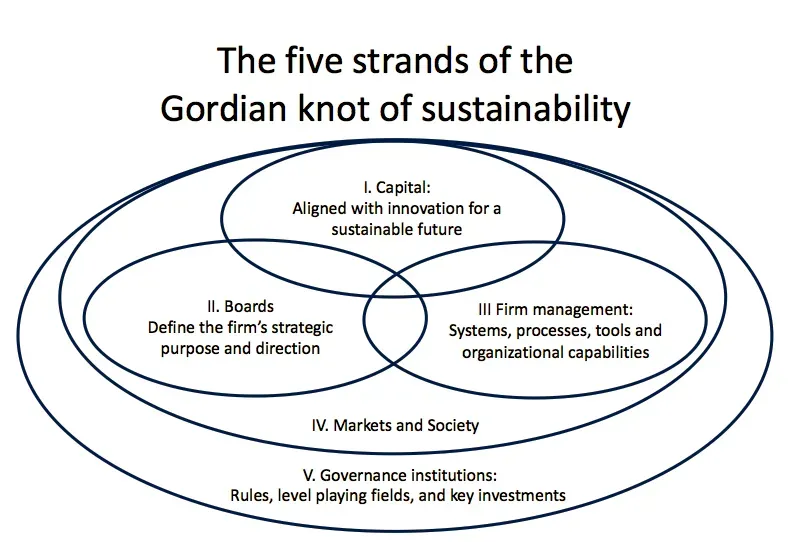My colleagues and I are writing a book, entitled Sustainability and the Future of Capitalism in Latin America. For all its flaws, we believe a capitalist system is the best system yet devised to meet human needs, reward human endeavor, allocate resources, and create a just, sustainable future. Yet not many would argue that capitalism has lived up to its promise. Too few, particularly in Latin America, have participated in its benefits, and its achievements have come at an enormous cost to the environment. Largely because of these failures, a recent book by three Harvard Business School professors argues that global “capitalism is at risk.”
In our book we examine how capitalism in Latin America can address the region’s very real sustainability challenges, and how capitalism can adapt to address them. In Latin America, challenges of sustainability are more acute -- some of the highest economic and educational inequality in the world, very high vulnerability to climate change, loss of biodiversity, the need to adapt to new technologies, among others -- and public and private institutions are weaker than in many other regions. Diagnoses and solutions must be tailored to Latin America.
As we write the book, before it is published, we would like to engage in an experiment with you, our prospective readers. Every two weeks over the next several months we will publish summaries of the argument in each of its eight chapters. We invite you to comment, enrich, disagree with the argument in each of the chapters (Please feel free to send us your comments to: richard.wells@lexgrp.com | rpwells@me.com). Though we will not be able to address all the comments we receive individually, we will take them into account and acknowledge them in the book. We hope this process will make the book better and more useful to you.
Below you will find the first installment of bi-weekly summaries. We look forward to an enriching conversation!
The context: Capitalism at Risk
In 2007, in anticipation of the 100th anniversary of its founding, the then-dean of Harvard Business School (HBS) commissioned three of its most prominent professors to conduct a study of the state of capitalism with a view to determining what HBS should teach future generations of students. The HBS team worked with the school’s global alumni, organizing their study around 11 “stressors” to the global economy identified by the World Bank. Many of the stressors had to do directly with sustainability as defined by the UN Sustainable Development Goals (SDGs)—environmental degradation, inequality, education, and public health. Others can be seen as consequences of, or reasons for, failures to attain sustainability—populism, migration, failure of the rule of law, institutional weakness.
The HBS team’s conclusion should be a wakeup call for anyone who considers capitalism an effective, if imperfectly applied, instrument to meet human needs, compensate labor and capital, promote innovation, and allocate resources. In the 2011 edition of the book, Capitalism at Risk, the authors wrote that if capitalism did not adapt, within 25 years it would face a “rocky road.” Eleven years later, the same authors wrote in the 2020 revised edition of the book:
We had hoped that in calling attention to these problems (in the 2011 edition) we would spur leaders in government and business in the United States and abroad to take action. Since that time, the problems we wrote about have worsened and efforts to address them have fallen far short of what’s needed. Today, the very foundations of the capitalist system are under threat by an array of demographic, environmental, political, economic social, and technological forces around the world.
Is Capitalism at Risk in Latin America?
I had written a short book in 2019, Mexico Facing the Future concerning Mexico social institutional and business “future readiness.” The book had found that Mexico:
- Was highly vulnerable to technological disruption economically, socially, and environmentally. Rapid technological change would exacerbate this vulnerability.
- Was poorly prepared to participate in a future knowledge economy that required modern, effective educational systems and resilient, innovative businesses.
- Lacked “future-ready” public and private institutions.
Influenced by the HBS study, I undertook a study of Sustainability and the Future of Capitalism in Latin America, with two colleagues, Alvaro de Garay and Miguel Angel Valenzuela, experts respectively in corporate governance and sustainability management. We propose as an organizing concept what we call the Gordian Knot of Sustainability.

The gordian knot can only be solved by working simultaneously with each of its strands. As businesses, we have pulled at the “firm management” strands of the Gordian Knot to improve corporate sustainability performance--operational efficiency, charity, corporate social responsibility, shared value, management systems, voluntary environmental programs, reporting, circularity, stakeholder engagement, sustainable finance, green innovation. Despite inspiring individual anecdotes, these actions have seldom contributed to real improvement where it counts—in national and regional statistics concerning key parameters such as greenhouse gas emissions, inequality, education, loss of species diversity, and deforestation. We will only achieve real progress when we address the strands of the gordian knot as a whole:
- Corporations must see sustainability not primarily as a management problem but fundamentally as a corporate governance issue. Ultimately, the owners of capital must be accountable to society for the sustainability of the companies they own. Boards represent, first and foremost, the interests of capital. Management’s mandate derives from the strategic purpose of the company defined and overseen by the board.
- Sustainability will not succeed if it is divorced from societal and market needs. It must account for the needs of customers, but also for those of stakeholders, both those who have a voice and those who have no voice—marginalized communities, future generations, and the natural environment.
- Corporate sustainability leaders cannot do it alone. They need a regulatory, social, and physical infrastructure provided by a wide array of governance and social institutions. These institutions set the rules and conditions within which businesses operate, hold firms accountable for their performance and, crucially, protect responsible businesses from free riders who seek competitive advantage in ignoring sustainability. They provide the needed physical and intangible infrastructure required for a sustainable society. Governance institutions include national, state, and local governments, regulatory and infrastructure agencies; national and international financial regulators and intermediaries; standards setting bodies; research centers and educational institutions; business associations and NGO’s.
The need for Latin American models
European, advanced Asian and U.S. models do not address the reality of Latin America where the challenges of sustainability are more acute and the means to achieve it are different-- firm ownership structures is more concentrated, most firms are family owned small and mid-sized businesses, sustainability is not on the agenda of most corporate boards, innovation systems are inadequate and government institutions are weak. On the other side of the ledger, according to a recent global survey, populations in Latin American countries, particularly minority populations, are among the most concerned about sustainability, and individuals are among the most inclined to change behavior to more sustainable lifestyles. Among the five companies rated highest by global sustainability experts four are, like most Latin American companies, closely held corporations (full disclosure: I was one of the “experts.”)
Questions for our readers
This article summarizes the conceptual framework for the book. Over the next several months we will be delving into each topic in greater detail as we prepare the final draft of the book. We would like to integrate a wide range of your views and opinions and would appreciate your input. We may not be able to incorporate all comments in the final text, but we will summarize the major themes and acknowledge your contributions. Here are some questions that we ask you to think about:
- What should be the role of business in achieving a just and sustainable future for the societies where it operates?
- Does the gordian knot describe the key actors who must engage.?
- What are the strengths and weakness of Latin America in each of the five “threads” of the gordian knot?
- What are the critical action steps that Latin America can take?
- Numerous Latin American countries have pulled back from a commitment to sustainability. What can business do in the absence of government action?
Please feel free to send us your comments to:
richard.wells@lexgrp.com | rpwells@me.com
The author is Associate Professor at EGADE Business School.
